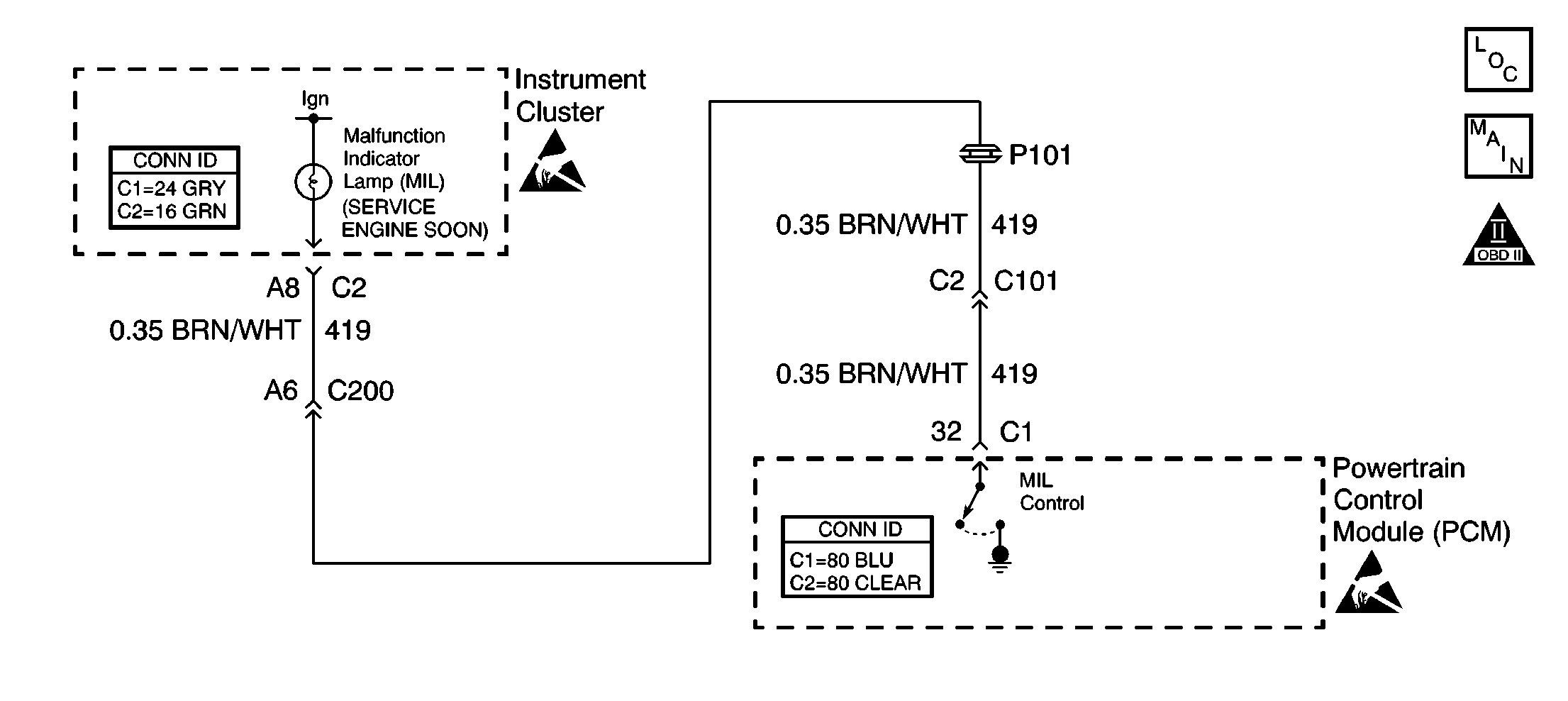
Circuit Description
The PCM uses output driver modules (ODMs) to control many functions of the engine, and the transaxle. The ODMs supply the ground path for the PCM controlled device when the PCM commands the device ON. Each ODM is able to control several outputs. Unlike the quad driver modules (QDMs) used in earlier model years, the ODMs are able to diagnose each output circuit. The PCM monitors the ODMs for circuit conditions that are incorrect for the commanded state of the ODM. If the PCM detects an improper circuit condition in the ODM that controls the Malfunction Indicator Lamp (MIL), DTC P0650 will set.
Conditions for Running the DTC
| • | The engine is running. |
| • | System voltage is between 8-16 volts. |
Conditions for Setting the DTC
| • | The PCM detects an improper voltage level on the output circuit that controls the MIL. |
| • | The condition exists for at least 10 seconds. |
Action Taken When the DTC Sets
| • | The PCM illuminates the malfunction indicator lamp (MIL) during the second consecutive trip in which the diagnostic test runs and fails. |
| • | The PCM stores the conditions present when the DTC set as Freeze Frame/Failure Records data. |
Conditions for Clearing the MIL/DTC
| • | The PCM will turn the MIL OFF after the third consecutive trip in which the diagnostic runs and passes. |
| • | The history DTC will clear after 40 consecutive warm-up cycles have occurred without a malfunction. |
| • | The DTC can be cleared by using the scan tool Clear DTC Information function. |
Diagnostic Aids
To determine whether an improper voltage level exists on the output circuit, the PCM compares the voltage level to the commanded state. For example, a failure condition exists if the PCM detects a low voltage level when the device is commanded OFF, or a high voltage level when the device is commanded ON.
Check for the following conditions:
| • | Poor connections at the PCM or the instrument panel cluster (IPC) -- Refer to Testing for Intermittent Conditions and Poor Connections in Wiring Systems. |
| • | A damaged harness -- Inspect the wiring harness for damage. If the harness appears to be OK, disconnect the PCM and Turn ON the ignition. Connect a voltmeter between the MIL control circuit and chassis ground. Observe the voltmeter while moving connectors and wiring harnesses related to the MIL. A change in voltage will indicate the location of the malfunction. If a problem is found, repair as necessary. Refer to Wiring Repairs in Wiring Systems. |
Reviewing the Fail Records vehicle mileage since the diagnostic test last failed may assist in diagnosing the condition. The information may help determine how often the condition that set the DTC occurs.
Step | Action | Values | Yes | No |
|---|---|---|---|---|
1 | Did you perform the Powertrain On-Board Diagnostic (OBD) System Check? | -- | ||
2 |
Is the MIL ON? | -- | ||
3 | With the scan tool, command the MIL OFF. Is the MIL OFF? | -- | Go to Diagnostic Aids | |
4 |
Did you find and correct the condition? | -- | ||
5 |
Is the test lamp ON? | -- | ||
6 |
Did you find and correct the condition? | -- | ||
7 |
Does the test lamp turn ON and OFF? | -- | ||
8 |
Did you find and correct the condition? | -- | ||
9 |
Did you find and correct the condition? | -- | ||
10 |
Did you find and correct the condition? | -- | ||
11 |
Important:: The replacement PCM must be programmed. Replace the PCM. Refer to Powertrain Control Module Replacement/Programming . Is the action complete? | -- | -- | |
12 | Replace the IP cluster. Refer to Instrument Cluster Replacement in Instrument Panel, Gauges, and Console. Is the action complete? | -- | -- | |
13 |
Does the scan tool indicate DTC P0650 passed? | -- | System OK |
